Samsung SSD XP941 Review: The PCIe Era Is Here
by Kristian Vättö on May 15, 2014 12:00 PM ESTRandom Read/Write Speed
The four corners of SSD performance are as follows: random read, random write, sequential read and sequential write speed. Random accesses are generally small in size, while sequential accesses tend to be larger and thus we have the four Iometer tests we use in all of our reviews.
Our first test writes 4KB in a completely random pattern over an 8GB space of the drive to simulate the sort of random access that you'd see on an OS drive (even this is more stressful than a normal desktop user would see). We perform three concurrent IOs and run the test for 3 minutes. The results reported are in average MB/s over the entire time.
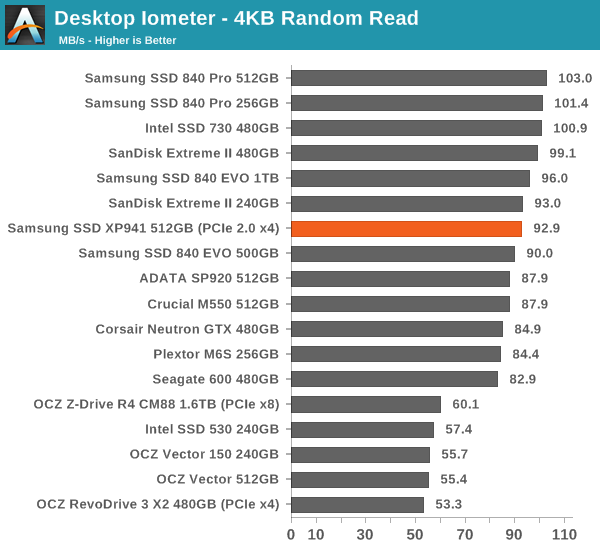
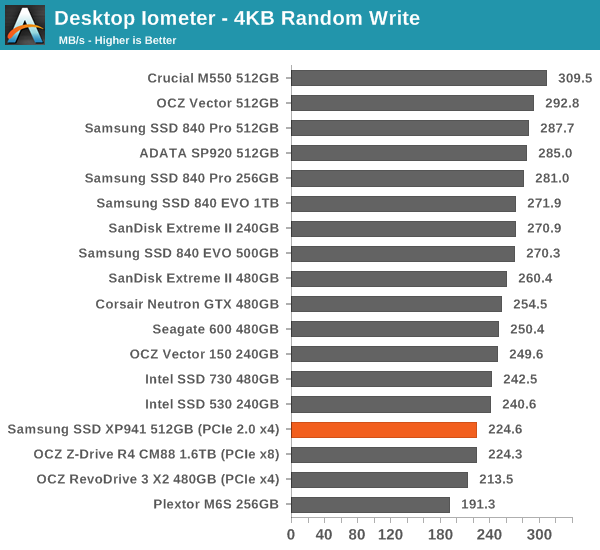
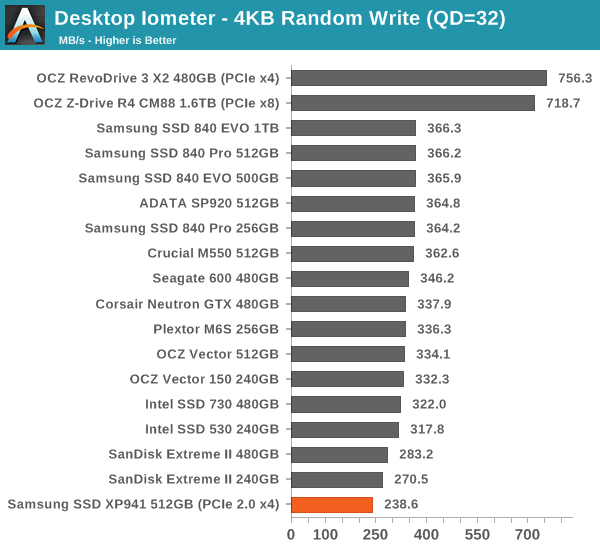
The random performance of XP941 doesn't stand out. Especially random write speeds are quite low by today's standards and queue depth scaling is close to non-existent. That said, I don't believe that high queue depth performance is really important for client workloads as our internal workload analysis shows that even under heavy use the average queue depth tends to be no more than 5. Our Storage Benches also show that even though the random performance isn't excellent, the strong sequential performance thanks to the faster PCIe interface makes up for the difference.
Sequential Read/Write Speed
To measure sequential performance we run a 1 minute long 128KB sequential test over the entire span of the drive at a queue depth of 1. The results reported are in average MB/s over the entire test length.
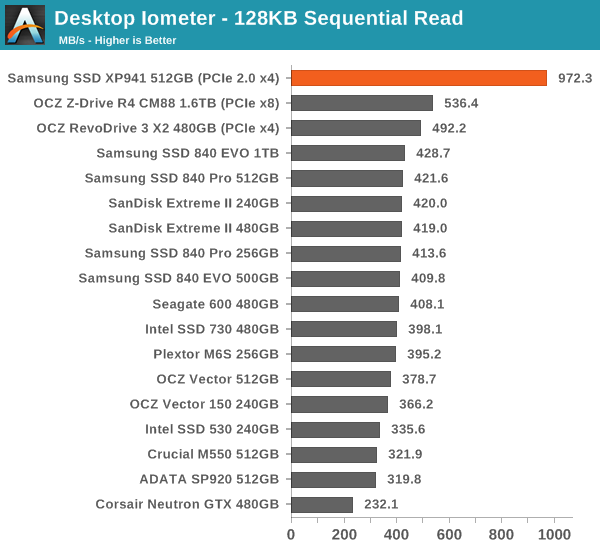
The sequential speeds are the highest we have ever tested in a consumer SSD. Even the 8-controller Z-Drive R4 behemoth can't beat the XP941, which really speaks for the efficiency of a single controller design. If you were to increase the queue depth, the Z-Drive would easily beat the XP941 since higher queue depth would increase parallelism and the Z-Drive could take advantage of all of its eight controllers. However, I was able to reach speeds of up to 1560MB/s with the XP941 at queue depth of 32, which is pretty much as fast as you can go with PCIe 2.0 x4 without tweaking any settings (the PCIe bus can be overclocked to achieve even higher speeds, though there can be a negative impact on random performance. We will investigate this at a later date).

AS-SSD Incompressible Sequential Read/Write Performance
The AS-SSD sequential benchmark uses incompressible data for all of its transfers. The result is a pretty big reduction in sequential write speed on SandForce based controllers. The XP941 does brilliantly in AS-SSD as well but now the strength of eight controllers starts to show for the Z-Drive. Even then, the XP941 is still about twice as fast as the fastest SATA 6Gbps SSD.
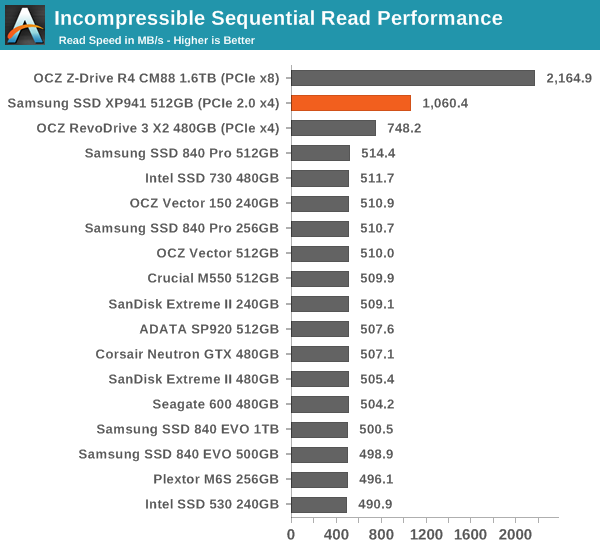
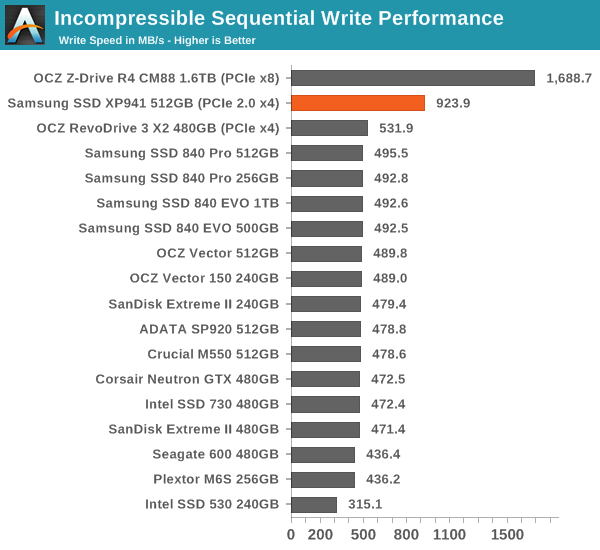










110 Comments
View All Comments
RamCity - Monday, May 19, 2014 - link
The Lycom M.2 to PCie adapter does a reasonable job with small form factor computers. It has a low-height bracket in addition to the standard height one. Note though, you can't boot the XP941 in any windows PC with one of these adapters as far as we know - it wont show up in the bios as a bootable device. Only in a 2006-2012 Mac Pro under OSX will it be bootable.Rod
Oscarcharliezulu - Monday, May 19, 2014 - link
Nice job anandtech... You detected what country i was reading this from and inserted appropriate text/prices? Great job. Appreciated.kizh - Tuesday, May 20, 2014 - link
still running my sandy 2500k that did 4.8 reliably until I updated bios. I bought a z67 board that had a pcie 3.0 x 16 lane as an early adopter. The only thing worth upgrading on it was the graphics so bought a 780 (on accident thought it was a 780 ti) I spent about 24 hours of my time researching making it work on a early version of uefi and trying multiple set ups. Gonna send it back, its not worth upgrading my whole system for this.Never buying another feature that isn't being used yet, by the time its truly a standard your warranty is over and FU if it got tweaked a little.
Got 2 M2 in raid, no trim ever bothered me. Its fast enough, don't need this. Maybe if a whole system upgrade was as fun as it used to be,
Right now all I see waiting for is a 4k display port standard and some nicer models coming out. I want to throw money at these guys but not for next to nothing,
I'm not rich by any measure but dumped money on tech as a hobbyist.
kizh - Tuesday, May 20, 2014 - link
oh just to clarify I know it would only be pcie 3.0 with ivy, I didn't expect that chip to be such a let down. Still this should have worked at pcie 2.0. Also when I say m2 I'm talking about the model name of my ssd's. not m.2just some clarifications
sfgebrqy - Wednesday, May 21, 2014 - link
I would have bought this in a heart-beat if it weren't for two things:1) Average/bad 4k random read/write
2) Abysmal 4k scaling with QD
The killer feature for this SSD is without a doubt its sequential performance. Compared to any single SSD alone, it blows it out of the water on the benches, whether
practical or synthetic.
The caveat is "single SSD". RAID 0 can always be used to boost sequentials. Maybe not exactly linearly, but close to linearly. Take a look at the review for 2 Samsung 840
Pros in RAID 0 (page 3). I can't link (or even mention the website) it because the comment filter says its spam, so take a guess and use Google. Sequentials are nearly
doubled for both read and write.
The kicker is that this CANNOT be done for random I/O at low QD. Which is to say, if we wanted better random I/O from XP941s, we couldn't RAID them together to do it. In
fact, RAID typically makes random I/O marginally worse at low QD due to overhead. See the aforementioned review (page 4).
RAID does multiply random I/O at high QD, but with XP941 4k QD scaling non-existent to begin with, it's a lost cause.
Even if we did want to RAID XP941s together, I can't seem to find any tests/reviews of more than two at once, let alone a RAID controller capable of putting more than two
M.2 devices in RAID 0. Meanwhile, there are plenty of RAID controllers capable of pushing 16+ SATA3 devices (albeit bottlenecked at x8 PCIe 3.0).
The bottom line is that if I found out that my current SATA3 SSD RAID 0 array wasn't putting out enough sequential, I could just add a few more SSDs to solve the issue. If I
found out that my XP941 array wasn't putting out enough random I/O, there's nothing I could do to fix it.
If you're in the market for single SSDs and your system can handle M.2, then this is the cream of the crop. If you have RAID arrays though, wait until M.2 becomes more
popular and Samsung pushes a new M.2 SSD with better random I/O performance.
skrewler2 - Sunday, May 25, 2014 - link
Sorry late to the party but this part of the article is just ignorant:"Using an SSD as a secondary drive can make sense for e.g. a video professional where the performance can be utilized as a scratch disk, but otherwise the only real use case for an SSD is as a boot drive"
What the hell?
aviv - Wednesday, June 4, 2014 - link
Hey gr8 reviewI got question about the graphs
Its log systemic
Does it means when its lower by 1/10 its just half of the value or
In between its linar
brentpresley - Thursday, July 3, 2014 - link
ASUS just released a new BIOS today (7/3/2014) that allows for M.2 boot support of the XP941.I just installed it and the BIOS can see the XP941 in AHCI mode now.
iBurley - Wednesday, December 3, 2014 - link
If put into the M.2 slot of one of the ASRock Z97 boards mentioned in the review, will this be running at full speed, or would I need an adapter like you tested with to use the full potential of the drive?On ASRock's website, under the port listing for the board, it states "1 M.2 (PCIe Gen2 x2 & SATA, Supports 30mm, 42mm, 60mm, 80mm, 110mm M.2 devices)" but I don't know if that just means the interface or if it would actually go over the PCIe bus instead of SATA.
SERGE 2015 - Tuesday, July 14, 2015 - link
I have AsRock's Z97 Extreme6 and XP941 and it is unfortunately NOT bootable out of the box. As it's been mentioned - once the system boots up using another EFI source, the XP941 becomes visible and can then load whatever been installed on it. This is due to lack of OpROM on XP941. The new Samsung SM951 been declared as "Supports Standard AHCI driver" though.